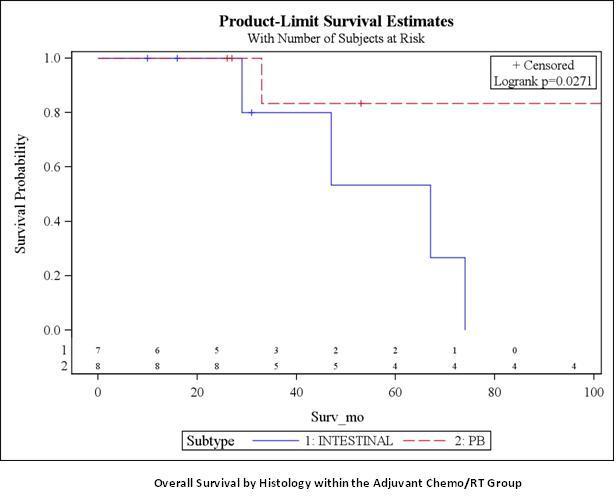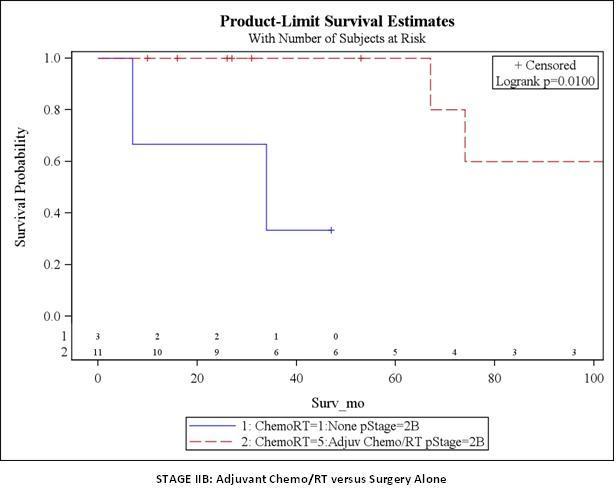|
Back to Annual Meeting Posters
The Role of Adjuvant Chemoradiotherapy in Pancreatobiliary Versus Intestinal Subtypes of Ampullary Cancers
Sanjay S. Reddy*, Harry S. Cooper, Karen Ruth, Yun Shin Chun, James C. Watson, John P. Hoffman
Surgical Oncology, Fox Chase Cancer Center, Philadelphia, PA
Background: Ampullary cancers traditionally have had more favorable outcomes than tumors in the pancreatic head. Current literature suggests the use of adjuvant therapies may be of benefit in populations with certain high risk features. Whether adjuvant therapies in specific histological subtypes influence outcomes has remained unanswered.
Methods: We retrospectively analyzed 44 patients from 1996-2010 at a dedicated cancer center. Pathological stage, histological subtypes(pancreatobiliary(PB) versus intestinal (INT)), margin status, lymphovascular invasion(LVI), perineural invasion(PNI), overall survival(OS) and disease free survival(DFS) were analyzed. Kaplan-Meier methods were used to estimate survival, and differences were assessed using the log rank and Wilcoxon tests. We looked at differences in survival by histological subtype within the adjuvant chemoradiotherapy(ACRT) and surgery only subgroups, accounting for stage.
Results: Of 44 patients, 15 were male and 29 female; average age was 64. Twenty patients underwent a classic pancreatoduodenectomy(PD), and 24 a pylorus preserving PD. Nine percent of patients were pathologic stage IA, 18% IB, 23% IIA, 36% IIB, and 14% III. Upon review by a senior pathologist, 25 patients were found to have a PB histology, 18 INT, and 1 mixed. LVI and PNI were found in 32% and 25%. Neoadjuvant chemoradiation was given to 3 patients. ACRT was given to 15 patients, adjuvant chemotherapy to 5, and adjuvant radiation to 2. Nineteen patients underwent surgical resection with no other modality. OS at 2 years was 75% for PB compared to 70% for INT; at 5 years, 63% and 46%, respectively(p=0.11). Within the ACRT group, the PB patients had improved OS than INT(p=0.027). DFS at 2 years was 63% for PB compared to 59% for INT; at 5 years, 58% and 28%(p=0.05). Within the ACRT group, the PB patients had improved DFS than INT(p=0.01). The choice between gemcitabine versus 5 fluorouracil (5FU) based regimens did not reach statistical significance when comparing survival. Comparing stage, IIBs showed improved OS and DFS than IIAs(p=0.05,0.006). Within IIBs, ACRT improved OS irrespective of histology(p=0.010). Stratifying PB patients within the IIB group, OS and DFS were improved compared to its intestinal variant when ACRT was given(p=0.03,0.02).
Conclusions: The use of ACRT in patients with ampullary tumors may be more important for survival than histologic type. Larger studies will be needed to distinguish the effects of adjuvant therapy from those on histologic type.
 

Back to Annual Meeting Posters
|



